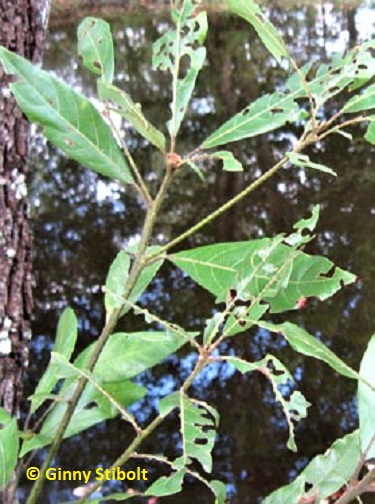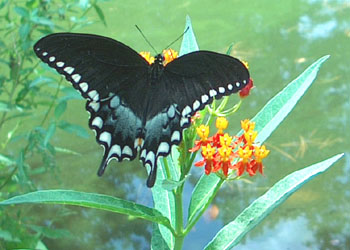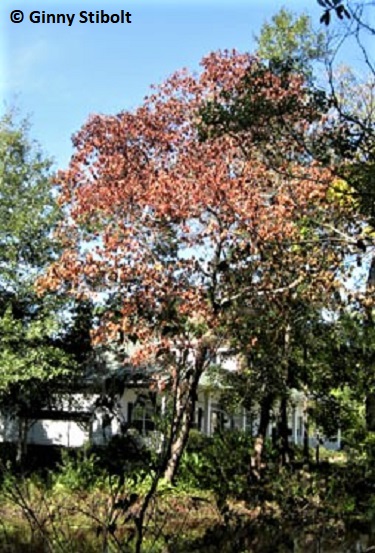Adventures of a Transplanted Gardener |
|||
Red bay trees are dying
| |||
 |
<< Leaves and fruit of the red bay provide a natural food source for a wide variety of desirable critters. The red bays support two types of butterflies: palamedes and spicebush swallowtail. Many birds and other animals eat the small blue fruits as well. The red bays will be sorely missed in the habitat.
The overall effect
Red bays are small evergreen trees reaching up to 50 feet high. The elongated leaves fall in the spring just before leafing out again. We have two full-grown trees on our property. The one out back is in a wooded area growing with pines, oaks, and sweet gums. One day a couple of months ago I noticed that it had turned brown. The other red bay is out by the front pond (See top photo.) and large parts of it have turned brown this fall and more branches are fading. The eaten leaves shown in the photo to the left are on suckers at the base of the tree. As you can see, they are not wilted yet, but they soon will be. We have small red bays growing in a number of areas on our property; maybe the beetles will skip over them.
While red bays have not been widely planted as landscape specimens, they are common in wooded areas throughout Florida. Folks managing habitats will need to replace them with alternatives for the wildlife. Other trees in the laurel family may also prone to this disease, but they are also the most likely replacements to fill the void in the habitat. A bigger concern for Florida agriculture is that avocados (P. americana) are closely related. This bug has already have been found on on a few avocados.
Diversity, diversity, diversity!
This epidemic is an excellent reminder of why diversity in the landscape is important. The problem for many landscapes is that if the developers found a good deal on one kind of tree, it becomes the predominant tree in this neighborhood. When a disease like this attacks, the cover is gone and homeowners have to start out again with saplings just like all those towns that lost their elms. So plant a wide variety of plants for better habitat and for better defenses against epidemics.
 |
Gorgeous spicebush swallowtail butterflies have been using the red bay trees as a host plant to lay their eggs. The caterpillars eat these leaves because it makes them taste bad and birds are more likely to choose other bugs to eat. As adults, the butterflies sip nectar from a variety of flowers including this tropical milkweed. >>
Support the butterflies
The spicebush swallowtail butterflies may start feeling the pinch once the red bays are gone. Its host plants include several species in the laurel family including, spicebush (Lindera benzoin), sassafras trees (Sassafras albidum), the highly invasive camphor (Cinnamomum camphora), and the red bay. Some sources say that they also use tulip trees (Liriodendron tulipifera) and sweetbay (Magnolia virginiana) that are in the magnolia family.
In our yard, in addition to the red bays, we have a number of sweetbay magnolias. I've removed any camphor trees that have sprouted in our meadows because they are invasive, but now maybe I'll leave a couple for the butterflies until they are large enough to flower-then I'll remove them. I'll also purchase some spicebush plants this year to replace the red bays as food for the butterflies. I have the perfect spot in the partial shade out by the front pond for them. I hope the beetles will move on and let the spicebushes feed the caterpillars of these gorgeous butterflies for many years.
(Update: In 2019 I wrote, "An update: red bay trees that died back from laurel wilt disease in 2008.")
Resources:
· A detailed article in Terrain.org with maps of the spread: Undefended
Buffet.
· An article on the red bay wilt fungus in Science
News Daly.
Ginny Stibolt is a life-long gardener, a botanist, a naturalist, and a garden writer. You may contact her or read more of her articles posted on her website: www.greengardeningmatters.com.
Copyright Ginny Stibolt


